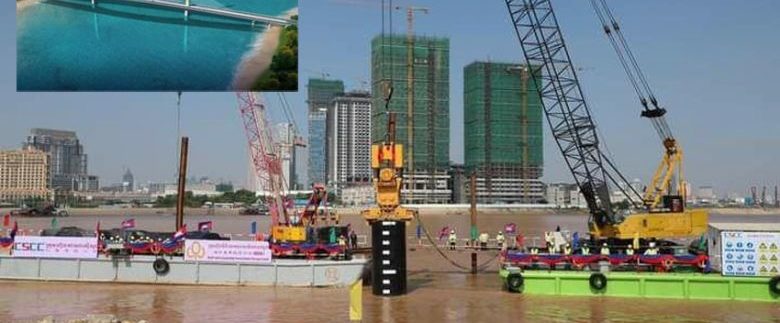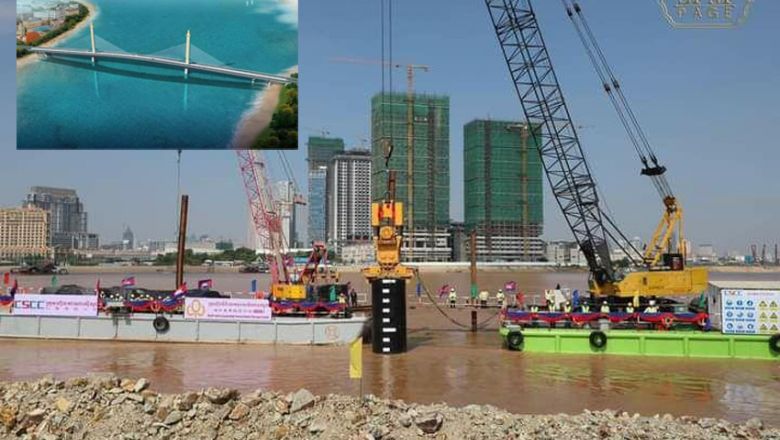Koh Norea Phnom Penh Cambodia


Koh Norea satellity city presses on amid Covid
Land reclamation presses on at a cracking pace in southeastern Phnom Penh’s colossal
125ha Koh Norea satellite city project a year on from the Covid-19 pandemic as
preliminary infrastructure development reaches 45 per cent completion, according to the
management of Overseas Cambodian Investment Corp Ltd (OCIC).
OCIC plans to spend a total of $2.5 billion to develop the project – located in Chbar
Ampov district’s Niroth commune opposite Koh Pich, which is also known as Diamond
Island.
The company is also building two bridges for $39.6 million, which broke ground in
October.
At 824m long and 24.5m wide, the first bridge will link Koh Pich to Koh Norea and feature
two 60m high cable-stayed pillars. It is expected to cost $38 million and take 35 months
to complete, with investment by OCIC and Chinese firm Cana Sino Construction Corp
(CSCC).
Measuring 60m long and 21m wide, the second bridge will also be cable-stayed and
connect Koh Norea to National Road 1.
Since January last year, OCIC has been filling the river bank with stone and sand, as well
as paving the riverbank with concrete as part of the preliminary infrastructure, which is
expected to be completed by the end of next year.
OCIC deputy director Touch Samnang told The Post on March 10 that the project had not
yet launched sales and that the company was focusing its resources on building the
infrastructure for the time being.
“Construction on the Koh Norea development project is proceeding according to
company plans. The spread of Covid-19 has not interrupted the process,” he said.
OCIC does not yet have an estimate for the number of large-scale constructions to be
built on the project, he admitted, noting that projections will hinge on economic growth
and the aggregate value of investment inflows.
He likened the project to Koh Pich, which now boasts scores of larger buildings and high-
rises.
Koh Norea is set to become a commercial centre and a “luxury” residential area teeming
with, inter alia, shipping districts, public parks, cinemas, luxurious homes and banks,
Samnang said.
Advance Real Estate Co Ltd founder and CEO Po Eavkong said the project had yet to have
a significant impact on property transactions and prices due to the current Covid-19
atmosphere.
“The real estate market there will rebound after more of the infrastructure is completed
and the situation of the Covid-19 epidemic is brought under wraps,” he said.
Speaking at the groundbreaking ceremony for the two bridges, OCIC CEO Pung Kheav Se
noted that the Council of Ministers issued letter No 1085 NS on October 28, 2018, which
granted the company permission to develop the project.
He said $550 million will be spent on infrastructure development in the satellite city,
including the bridges.
“The infrastructure project currently employs 700 people, and the figure could potentially
rise to 7,000 at the peak of construction activity.
“An additional 10,000 job opportunities will be on the horizon once the Koh Norea
development area is completed,” Kheav Se said, adding that the project will be able to
receive 50,000 residents upon completion.
OCIC set to spend $2.5B on capital’s satellite city
Local company Overseas Cambodian Investment Corp Ltd (OCIC) on Monday announced plans to spend a total of $2.5 billion to develop the Koh Norea peninsula in southeastern Phnom Penh into a new satellite city.
The announcement comes as the firm broke ground on two monumental bridge projects – one connecting Koh Pich in Chamkarmon district’s Tonle Bassac commune to the Koh Norea Development Zone in Chbar Ampov district’s Niroth commune, and another linking Koh Norea to National Road 1.
Speaking at the bridges’ groundbreaking ceremony, OCIC chairman of the board of directors Pung Kheav Se said $550 million of the capital investment will be spent on infrastructure development in the satellite city.
Developed on 125ha, the project will be able to receive 50,000 residents upon completion, he said.
“I would like to take this opportunity to thank the Royal Government of Cambodia for its continued support of the company’s development projects, in particular, the Koh Norea investment development project, which is developed by the Cambodian government as a new satellite city in Chbar Ampov district, Phnom Penh.
“The Koh Norea development project will bring a lot of socio-economic benefits to our country.
“Cambodia is in need of many more investment projects to sustain and reinforce its economy, especially in the face of the difficult economic conditions amid the global health crisis,” he said.

OCIC chairman of the board of directors Pung Kheav Se said at the bridges’ groundbreaking ceremony on Monday. SPM
Drawing from the $550 million earmarked for infrastructure, Kheav Se said the company will spend $39.6 million on the two bridges.
The first bridge linking Koh Pich to Koh Norea will be 824m long and 24.5m wide and feature two 60m high cable-stayed pillars. It is expected to cost $38 million and take 35 months to complete, with investment by OCIC and Chinese firm Cana Sino Construction Corp (CSCC).
The second bridge linking Koh Norea to National Road 1 will be cable-stayed, measuring 60m long and 21m wide.
Expected to cost $1.6 million and take some 12 months to complete, he said the bridge is designed by Cambodian engineers and will be 100 per cent built by a local company, Kheav Se said.
He pointed out that both bridges will have three lanes in each direction and two pedestrian lanes on either side.
Since January, he said, OCIC has been building concrete foundations and filling the river bank with stone and sand in preparation for the main infrastructure, bringing the satellite city to 27 per cent completion.
“The infrastructure project currently employs 700 people, and the figure could potentially rise to 7,000 at the peak of construction activity.
“An additional 10,000 job opportunities will be on the horizon once the Koh Norea development area is completed,” Kheav Se said.
He said infrastructure development for the satellite city is estimated to contribute about $225 million per annum to Cambodia’s gross domestic product (GDP) in its first three years, equivalent to nearly 0.9 per cent of the current GDP.
Speaking at the ceremony, Phnom Penh municipal governor Khuong Sreng said the two new bridges will greatly cut down on traffic congestion at the Monivong bridge and Kbal Thnal flyover.
He said they would facilitate people’s movement, help trim shipping costs and provide a greater competitive edge to the service sector.
“I would like to congratulate [OCIC] on the amazing strides they have made and on its decision to invest heavily in large projects in Phnom Penh and work closely with the Phnom Penh Municipal Hall in the rehabilitation, construction and development of physical infrastructure in the capital,” Sreng said.
He noted that Chbar Ampov was Phnom Penh’s 12th district and that it was partitioned from Meanchey district (now its western neighbour) in 2013 by the government.
Development in the district has garnered huge momentum and its geographical area has reeled in many large investment projects, he said.
These include, inter alia, high-rises, commercial centres, borey residential projects, shopping malls, restaurants and satellite cities representing capital investment of millions of dollars in just a few years, he added.
“This is not only a testament of the good cooperation in public-private partnerships, but also a reflection of the new-found success of the government’s policy implementation which strives to attract local and foreign investors.
“Of note, providing confidence to investors and businesspeople aims to contribute to national economic growth and shifting Phnom Penh’s development towards more civilised standards,” he said.
source: phnompenhpost.com

